Content
A successful intervention must be planned carefully to work as intended. A poorly planned intervention can worsen the situation — your loved one may feel attacked and become isolated or more resistant to treatment. An intervention presents your loved one with a structured opportunity to make changes before things get even worse, and it can motivate him or her to seek or accept help. For more information about treatment options, see NIAAA’s Treatment for Alcohol Problems booklet.

At the same time, it’s a way to get higher quality, one-on-one care that maintains privacy. Research shows that most people who have alcohol problems are able https://ecosoberhouse.com/article/alcohol-intervention-how-to-do-an-intervention-for-an-alcoholic/ to reduce their drinking or quit entirely. Overall, gather as much information as you can about the program or provider before making a decision on treatment.
Treatment for Alcohol Problems: Finding and Getting Help
Consequently, before beginning long-term alcoholism treatment, many patients require a detoxification period during which they become alcohol free under controlled conditions. Depending on the severity of the withdrawal symptoms, those services can be delivered in either an inpatient or outpatient setting. In addition to 12-step programs and behavioral therapies, one pharmacological agent, disulfiram (Antabuse®), has been available and used in alcoholism treatment since the late 1940s. Food and Drug Administration (FDA) also approved the medication naltrexone (ReVia™) for alcoholism treatment based on the results of randomized clinical trials. To date, however, naltrexone is not widely used, although pharmacotherapy has shown promising results in improving treatment outcome. Alcohol is a major contributor to global disease and a leading cause of preventable death, causing approximately 88,000 deaths annually in the United States alone.
The term “behavioral treatment” is used broadly here to include various nonpharmacological therapies whose objective is to change behavior (i.e., to reduce alcohol consumption). These approaches include behavioral therapy, cognitive therapy, various types of psychotherapy, counseling, and other rehabilitative strategies. To help colleges and universities identify https://ecosoberhouse.com/ interventions appropriate for their campuses, NIAAA created CollegeAIM—the College Alcohol Intervention Matrix—in conjunction with leading college alcohol researchers. CollegeAIM is a comprehensive, easy-to-use tool that rates nearly 60 individual- and environmental level interventions based on factors such as effectiveness, cost, and ease of implementation.
Advances in the science and treatment of alcohol use disorder
Ideally, health professionals would be able to identify which AUD treatment is most effective for each person. NIAAA and other organizations are conducting research to identify genes and other factors that can predict how well someone will respond to a particular treatment. These advances could optimize how treatment decisions are made in the future.
- A specialist can conduct the intervention, but the family members of the alcohol abusers have to be present during the session.
- An additional challenge to development of pharmacological treatments for alcohol use disorder is the high placebo response rates seen in drug trials (106).
- A talk therapy session could take place in a one-to-one, group, or family setting.
- If your loved one doesn’t accept treatment, be prepared to follow through with the changes you presented.
- These advances could optimize how treatment decisions are made in the future.
Controlled European studies have found that acamprosate treatment can almost double the abstinence rate among recovering alcoholics (Sass et al. 1996). Researchers in the United States are currently conducting a multisite randomized clinical trial of acamprosate. Hayashida (1998) has indicated that outpatient detoxification offers several advantages. For example, the patient may be able to use the same facility for both detoxification and subsequent long-term outpatient treatment. In addition, the patient may be able to more easily maintain family and social relationships and thus experience greater social support. Finally, the costs are lower for outpatient than for inpatient detoxification.
Behavioral Treatment Approaches and their Efficacy
This level of care allows patients to attend treatment during the day before heading back home when the day is over. In PHP, you’ll check in 5 days a week and will receive 4 hours of group therapy daily. Conversely, according to one large, well-designed study, disulfiram did not increase the rate of sustained abstinence or time to relapse among the patients (Fuller et al. 1986). In addition, only a subgroup of study participants (i.e., patients who showed evidence of greater social stability) drank less frequently when taking disulfiram than did patients with similar characteristics who received an inactive medication (i.e., a placebo) or no medication.
- In addition to the medications described here, scientists are evaluating other pharmacotherapeutic approaches to alcoholism treatment (for more information on recent advances and future trends in pharmacotherapy, see the article in this issue by Johnson and Ait-Daoud, pp. 99–106).
- For more information about treatment options, see NIAAA’s Treatment for Alcohol Problems booklet.
Individuals with alcohol dependence may drink partly to reduce or avoid withdrawal symptoms. Developmental factors are not the only consideration in designing preventive interventions. A person’s genetic makeup, health status, demographic and cultural background, and individual life experiences are also important factors, as is the broader sociocultural context in which one lives. This may include alcohol-related policies, community attitudes toward alcohol use, and exposure to social media. Such individual and environmental determinants, as well as interactions among them, affect the likelihood that a person will misuse alcohol, develop AUD, or suffer adverse alcohol-related outcomes. In the 1980s, animal studies discovered that naltrexone also reduced alcohol consumption.
Factors contributing to the effectiveness of treatments
An indirect meta-analysis of these two drugs concluded that nalmefene may be more effective than naltrexone (33), although whether a clinically relevant difference between the two medications really exists is still an open question (34). Network meta-analysis and microsimulation studies suggest that nalmefene may have some benefits over placebo for reducing total alcohol consumption (35, 36). The approval of nalmefene in Europe was accompanied by some controversy (37); a prospective head-to-head trial of nalmefene and naltrexone could help clarify whether nalmefene has added benefits to the existing medications available for alcohol use disorder. Last, nalmefene was approved in Europe as a medication that can be taken “as needed” (i.e., on days when drinking was going to occur).

The past decade has seen remarkable advances in alcoholism treatment research. Researchers and treatment providers now have a better understanding of the effectiveness of nonpharmacological treatments and of key elements in 12-step programs. In addition, research on effective pharmacotherapies for alcoholism is entering a new era.
What are the different levels of intensity for AUD treatment?
It is believed that the main reason the Sinclair Method has not caught on in the U.S. is two-fold. In the U.S., 12-step programs based on abstinence seem to dominate treatment plans prescribed by doctors, and doctors do not like that the Sinclair Method encourages people with alcohol dependency problems to continue drinking. With less than one percent of those seeking help for alcohol dependence receiving a prescription, medication is underutilized.
A large body of evidence shows that both individual and environmental interventions can be effective at preventing alcohol-related harm. Effective environmental interventions for college students include restricting happy hours and alcohol price promotions, banning Sunday alcohol sales, enforcing minimum drinking age laws, and increasing the cost of alcohol. „Although medical management is somewhat more intensive than the alcohol dependence interventions offered in most of today’s health care settings, it is not unlike other patient care models such as initiating insulin therapy in patients with diabetes mellitus.“
Groups for family and friends
It was first manufactured by Wyeth-Ayerst Laboratories under the brand name Antabuse. Disulfiram was first developed in the 1920s for use in manufacturing processes. The alcohol-aversive effects of Antabuse were first recorded in the 1930s.
- Thanks to years of research, doctors and health professionals now have a full menu of options to treat alcohol use disorders.
- People who are getting treatment for AUD may also find it helpful to go to a support group such as Alcoholics Anonymous (AA).
- You may not know what to do when your friend or family member drinks too much.
- AUD may be somewhat different for everyone, and for that reason, a variety of treatment approaches are available to better speak to each person’s individual needs.
Patients with less severe AUD may be able to receive treatment in primary care via brief interventions (see Core article on brief intervention) and FDA-approved AUD medications. For people with more severe AUD or with mental health comorbidities, it’s wise to seek evidence-based behavioral health treatment with a licensed professional therapist to set the stage for lasting change (see Core article on mental health issues). However, regardless of your level of alcohol abuse, seeking the guidance of medical and mental health professionals can promote a better understanding of this chronic disease and help inform the course of treatment that you ultimately select. Some alcoholics suffer from co-occurring psychiatric conditions, such as depression and anxiety. In some patients, these psychiatric conditions precede, and possibly even precipitate, alcohol abuse and dependence.
Currently, the vast majority of alcoholic patients are treated in outpatient facilities. Those programs offer alcoholism services of various intensity and duration. Day hospital programs (i.e., intensive outpatient programs) involve the patient for several hours per day, several days per week and were developed as alternatives to inpatient programs. Day hospital programs allow the patients to maintain their family roles while simultaneously receiving treatment. Less intensive out-patient services generally offer counseling sessions (i.e., group sessions, individual sessions, and—if necessary—family or couples therapy) once or twice per week. For many patients, those services are intended as maintenance therapy after the patients have received initial inpatient or intensive outpatient treatment.
- As a result of their varied treatment histories, the two groups differed in certain patient characteristics.
- Gaining a better understanding of recovery in the absence of treatment, particularly modifiable psychological, neurobiological, and epigenetic factors, could provide novel insights for medications and behavioral treatment development.
- Common side effects of naltrexone may include nausea, headache, dizziness, and sleep problems.
- Evaluate the coverage in your health insurance plan to determine how much of the costs your insurance will cover and how much you will have to pay.
- In addition, the typical length of stay in inpatient programs has decreased substantially.
- Emergency department (ED) clinicians are in a unique position to interact with people struggling with opioid addiction…

